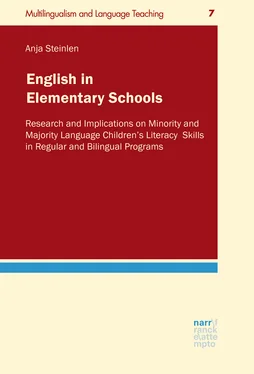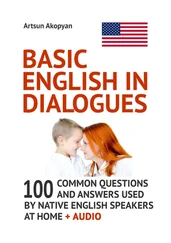2.2.5 Studies on FL writing in regular EFL programs
As previously noted, only few studies have examined students’ English text production in the elementary school context in Germany: for example, the BIG-study (BIG-Kreis, 2015) also tested the 2,148 fourth graders on their English writing skills using tasks particularly designed for this study. The four writing tasks included copying words, writing single words to label pictures and filling out a gap text with English words and sentences where the children provided information about themselves. As expected, the children’s scores related to matching and copying single words and providing an English word to label a picture were highest; and between 54% to 71% of these tasks were solved accurately (or comprehensibly). Half of the children managed to provide adequate information in the gap text (the so-called “semi-creative task”) despite the fact that text production is usually not trained in the FL elementary school classroom. Errors in these gap texts pertained to the omission of words, incorrect plural endings or subject-verb agreement. Common misspellings in all tasks included the words and , which were words that the teachers had used in listening and speaking but not in writing activities. Omissions were noted for the words as *; and transpositions for the words as *. The authors concluded that the children form hypotheses and construct rules with reference to existing experience and knowledge, many based on German, as in * instead of . In sum, students’ English writing skills were of much lower quality than their reading skills. This may be attributable to the fact that, according to teacher interviews, writing activities were carried out only in half of their classes on a regular basis, and that almost 20% of the teachers never let their students write in English.
Steinlen & Piske (2018a) also examined English writing skills of the 73 fourth graders in the FL program. The results of the subtest for reading (PSAK, Little, Simpson & Catibusic, 2003) showed that these children generally performed at level A1 with respect to their English writing skills. This outcome is in line with the expectations by the Ministerium Baden-Württemberg für Kultus, Jugend und Sport (2004, 2016a).
As this short literature review has shown, there is a need to examine the development of FL literacy skills in regular programs, in particular because the Federal States Baden-Württemberg and North Rhine-Westfalia have recently decided to postpone the beginning of FL classes from grade 1 to grade 3 (e.g., Ministerium Baden-Württemberg für Kultus, Jugend und Sport, 2020). There have been two main reasons for this decision. First, a growing number of elementary school children show deficits in German reading, writing and arithmetic on various achievement tests. It is argued that by delaying the FL lessons, the schools gain two lessons per class level which they can use to better support these students. Second, some recent studies have indicated that in the long run (e.g., in grade 7 or 9), younger learners who started English-as-a-subject in grade 1 showed neither medium- nor long-term benefits over older learners who started in grade 3. As Fleckenstein et al. (2020) pointed out in their review, such results may also be due to the quality of FL teaching in elementary schools (with the current focus on implicit learning and not on FL literacy input); the CEFR level A1 being too low a goal; and the transition to secondary education having a strong focus on explicit learning, deductive teaching of vocabulary, grammar and metalinguistic abilities, as well as on a greater number of assessments of FL reading and writing skills. This is also one of the reasons why, in all of the studies reviewed above, the authors concluded that it is overdue to introduce systematic literacy instruction in the regular FL classroom in Germany (including, for example, an approach to teach English spelling, see also e.g., Börner et al., 2017; Burwitz-Melzer, 2010; Hempel et al., 2018). With such standards, more teachers would hopefully feel obliged to offer writing activities, which in turn would also give them more possibilities for diagnostics and differentiation in class. Students would then receive additional support for autonomous learning and more diverse opportunities to become aware of the structures of the English language, in particular with respect to FL phoneme-grapheme correspondences and the segmentation of the speech stream (BIG-Kreis, 2015, see also chapter 7). Unfortunately, the Ministries of Education of the sixteen Federal States of Germany have not yet been able to agree on a common procedure (e.g., Börner et al., 2017; Burwitz-Melzer, 2010; Hempel et al., 2018).
2.3 Bilingual programs in Germany
Bilingual programs represent a more intensive way to acquire a new language within the school context. According to Wolff & Sudhoff (2015: 9), bilingual teaching can generally be defined as a methodological concept in which learning school content is carried out in a language that does not correspond to the school language (usually the majority language). Of the 15,409 elementary schools in Germany, more than 2% are currently offering a bilingual program, corresponding to more than 330 elementary schools. In these schools at least one content subject (e.g., science, music, physical education, math) is taught in the new language. The target language in German elementary schools is usually English or French (FMKS, 2014).
The general aim of bilingual programs is to foster both FL learning and content learning (e.g., Coyle, Hood & Marsh, 2010). The Eurydice report (2006: 22) points to four additional objectives. Following Elsner & Keßler (2013), these include socio-economic objectives (to prepare students for life in a more internationalized society and to offer them better job prospects on the labor market); socio-cultural objectives (to teach students values of tolerance and respect vis-a-vis other cultures through the use of the target language); linguistic objectives (to enable students to develop language skills which emphasize effective communication and to motivate them to learn languages by using them for real practical purposes); and finally educational objectives (i.e., subject-related knowledge and learning ability, to stimulate the assimilation of subject matter by means of a different and innovative approach).
Next, chapters 2.3.1-2.3.4 describe general characteristics of bilingual programs, and chapters 2.3.5-2.3.8 summarize curricular baselines for bilingual education, teacher education, supply of materials and various aspects of assessment in bilingual programs in Germany. Finally, the results of empirical studies on reading and writing skills in bilingual programs in Germany are provided in chapters 2.3.9-2.3.12.
2.3.1 Differences between bilingual programs and EFL programs
The main differences between bilingual programs and regular FL lessons was outlined by Burmeister (2006), who compared regular FL teaching with intensive bilingual (immersion, IM) teaching in the elementary school context. In bilingual lessons, subject matter is taught using a foreign language. In regular FL lessons, the reverse is true: here, foreign language skills are taught with the help of subject matter. One could argue that the teaching materials for regular English lessons in elementary education also provide a variety of topics, e.g., units on animals, on the human body, or topics relating to cultural studies. The crucial difference between bilingual and regular FL programs, however, is based on the objective and thus on the respective function of language and subject matter as the subject of learning.
Burmeister (2006) provided the following example: in regular FL teaching, the topic “animals” may have been chosen because it reflects the interests of elementary school children and is therefore motivating. Additionally, the topic may already constitute the following unit in the textbook and/or perhaps it may just fit the topic taught in science (which is conducted in the majority language, in this case: German). However, the main reason for choosing this topic is that it provides linguistic input to train listening, speaking, reading or possibly writing skills in the FL. The topic thus acts as a vehicle for deliberately exercising and circulating selected linguistic structures and vocabulary. In contrast, the topic of “animals” would be chosen in the bilingual classroom because it is included as a topic in the curriculum for the subject “science” for grade 1. This topic, therefore, is genuinely based on the curriculum of a non-language subject, and the learners’ involvement with its content in the FL is authentic. The L2 acts as a vehicle to transport content; and the selection of linguistic means arises directly from the respective topic (Burmeister, 2006).
Читать дальше












